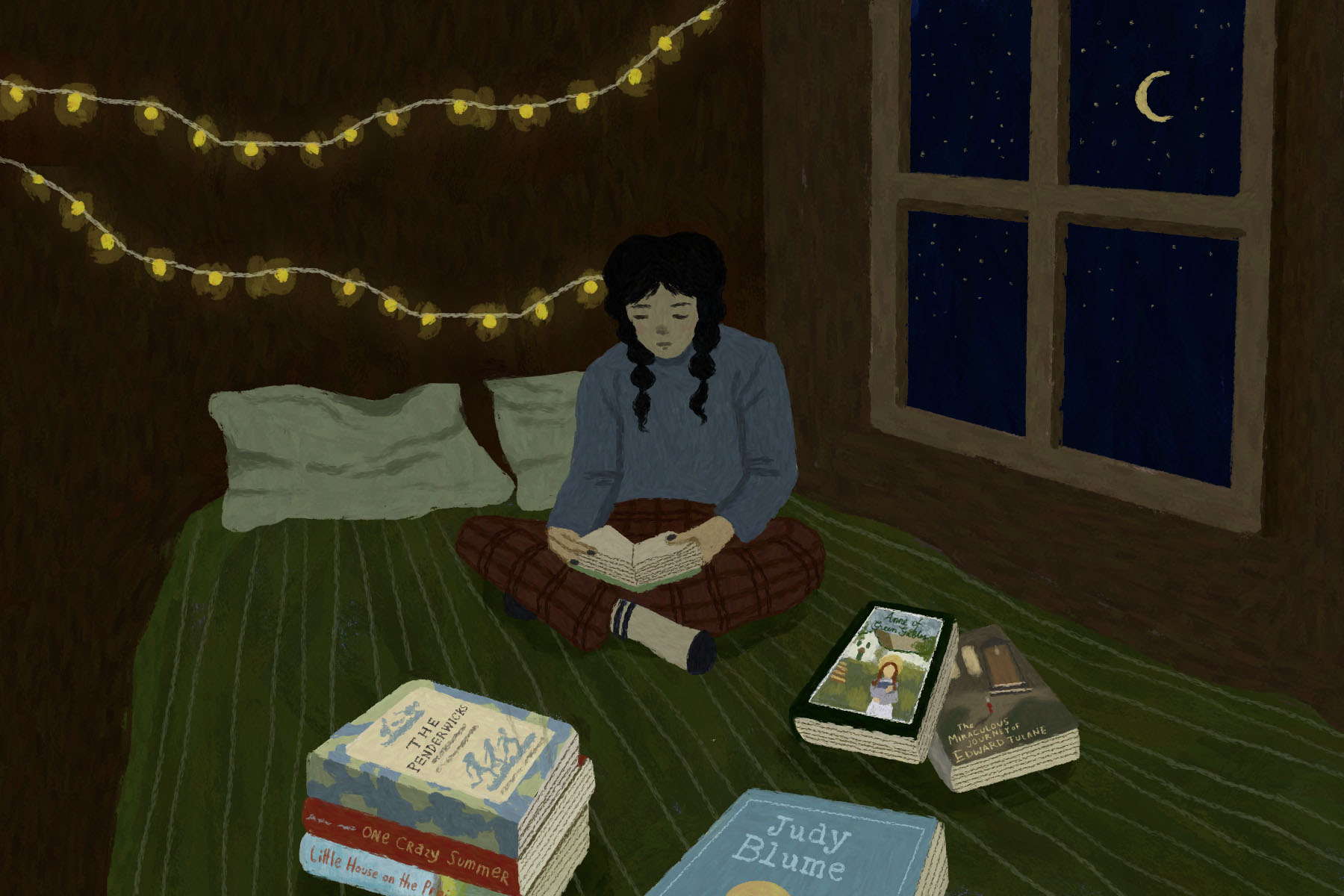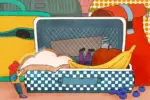As autumn quickly approaches alongside the upcoming fall semester, it is important to carve out time for oneself reserved just for rest. With a mug of hot cocoa or warm herbal tea — or lemonade, depending on the weather — here are some books for children that nourish the mind and heart. Revisit youth in the yellowed pages, and cherish it.
“Anne of Green Gables” by L.M. Montgomery, 1908
“I’m so glad I live in a world where there are Octobers,” 11-year-old Anne Shirley exclaims in the widely-beloved novel. Whimsical and charming, the book follows Anne as she navigates her new life on Prince Edward Island after a pair of quiet siblings adopt her. One of the most endearing characters in all of fiction, Anne is characterized by her vivacity and proclivity for getting into trouble. She manages to get into some sort of absolutely-preventable scrape every chapter and spends quite a bit of her time profusely apologizing to the various people she has accidentally wronged.
In a mishap that greatly distresses Anne, she serves her friend Diana currant wine, mistaking it for the non-alcoholic raspberry cordial she wanted to drink. Anne ends up begging forgiveness of Diana’s austere mother, who frowns at finding her daughter ill from the intoxication and blames Anne. A hardy yet sensitive girl at heart, Anne refuses to let paltry concerns like falling off a roof ruffle her feathers, but smaller incidents such as being called “carrots” for red hair incite in her a rage so violent she cracks her slate over the offending schoolboy’s head. Anne brims with energy and passion; her endless antics are only a result of that, and the reason her character has remained so loved for over a century.
Anne’s troublemaking tendencies, however hilarious, do not alone propel her to the status of classic literary heroine. Entering a new place with parental figures and friends she always dreamed of, Anne approaches her life with gratitude and wonder. The things most people take for granted, Anne cherishes deeply. She appreciates Prince Edward Island’s natural beauty; as she sees the landscape for the first time she asks of her adoptive father, “Isn’t that beautiful? What did that tree, leaning out from the bank, all white and lacy, make you think of?” She goes on to describe the bride she imagines, “a bride all in white with a lovely misty veil.” Anne’s love for life has infected readers for 115 years and counting.
“The Penderwicks” by Jeanne Birdsall, 2005
Rosalind, Skye, Jane and Batty Penderwick are the light of their father’s life, and also quite a handful. “The Penderwicks” tells the tale of the four sisters’ escapades over a warm summer vacation. Their father accidentally rents a mansion called Arundel instead of a small cottage in the Berkshires, which turns out to be a blessing in disguise. The girls meet and befriend the kind neighbor boy, Jeffrey, and with him make memories to last a lifetime. Readers have the absolute joy of being along for the ride.
Summer drama ensues almost immediately after the Penderwicks arrive at their vacation home and does not stop for a moment until they depart for home. Twelve-year old Rosalind finds herself infatuated with the 19-year-old gardener, who shows the girls his pet rabbits Yaz and Carla on a lazy day. Four-year old Batty must be saved by Jeffrey when she wanders into a field to investigate a patch of clovers and daisies, only to find herself staring down an annoyed bull. The summer at Arundel features almost-concussions, accidental eavesdropping, burnt cookies and a disastrous birthday party. The Penderwicks and Jeffrey, with ages ranging from four to 12, epitomize the experience of youthful summertime, free and wild and fun.
“The Penderwicks” flawlessly captures the peculiar dynamics that can only exist between young siblings. The sisters employ the use of various acronyms to communicate efficiently: MOOPS (Meetings Of Older Penderwick Sisters), MOPS (Meetings Of Penderwick Sisters) and OAP (Oldest Available Penderwick) primarily. Banter between the girls carries little import because they find themselves arguing over mundane things just to get on each other’s nerves. The spelling of “kangaroo” becomes a contentious topic, as does the topic of who is responsible for the map being eaten by the dog. The girls bicker, and the girls play, and the girls love each other to pieces.
Despite its young target audience, a standout theme of the novel is grief. A thread of melancholy stitches into the pages because the Penderwick girls lost their mother four years prior to their wonderful summer, following Batty’s birth. Each Penderwick honors their mother uniquely: Rosalind keeps a photograph of her mother next to her bed while Batty loves hearing stories about her at bedtime. The four sisters talk about their mother in Heaven, how they wish she could see the lush Arundel gardens but know Heaven’s gardens are far prettier. Their grief has faded with time to the point that what the Penderwick daughters carry with them each day is a palpable love for their mother.
Readers find themselves falling in love with the sisters’ rawness and honesty as they face life bravely and with unending humor. The Penderwick family’s drama does not end at Arundel, but continues for four more books, finding its conclusion 15 years later in “The Penderwicks at Last.”
“Little House on the Prairie” by Laura Ingalls Wilder, 1935
“Little House on the Prairie” is the stirring second book in the series loosely based on Laura Ingalls Wilder’s life as a young pioneer girl. In the novel, the Ingalls family — consisting of Pa, Ma, Mary, Laura and Baby Carrie — journeys from the Wisconsin woods to the Kansas plains. It takes place in the early 1870s, when Laura is about five years old and her sister Mary six. The events that transpire are interpreted through the eyes of a little girl. Laura lives with the unabashed enthusiasm and energy that only a small child possesses, that her exasperated but loving parents can never seem to discipline.
The magic of “Little House on the Prairie” originates from the sense that everything is larger than life. The vast prairie and the even vaster sky stretch around the Ingalls family into the horizon. A loneliness that only serves to emphasize the grand scale paints the book, as Laura remarks of her new home, “And on the whole enormous prairie there was no sign that any other human being had ever been there.” The world is infinite and full of promise to small Laura. Her girlhood overflows with exploration, her days are full with play, and Laura learns what it means to be a pioneer girl on the Kansas prairie.
In the final scene of “Little House in the Big Woods,” the book preceding “Little House on the Prairie,” Laura tries to sleep as Pa plays his fiddle and Ma knits in the firelight. She reflects, “They could not be forgotten, … because now is now. It can never be a long time ago.” Now that 150 years have passed since Laura laid so quietly by the fire, it is a long time ago, despite her childhood certainty in eternity. And yet the life she led lives on in the prose of her novels; on paper, Laura Ingalls is still five years old and eating pancakes, bacon and molasses as the sun rises on the prairie grass.
“The Miraculous Journey of Edward Tulane” by Kate DiCamillo, 2006
This novel is a surreal masterpiece about learning to lose and learning to love. Edward Tulane, a china toy rabbit, enjoys the unconditional love of his owner Abilene, but does not love her back. When Edward finds himself accidentally flung overboard the ship Abilene’s family vacations on, he begins an odyssey of personal growth that will last 30 years. In and out of various owner’s hands, both cruel and kind, Edward experiences the world and witnesses humanity as he never did under the care of Abilene. The owners he learns to care for, and even love, he often loses. Edward grows into a rabbit who can love despite the risks, whose love can persist through heartbreak.
Rife with moving quotes that speak to truths about humanity, this novel warms the heart. About loving for the first time, DiCamillo writes, “I have learned how to love. And it’s a terrible thing. I’m broken. My heart is broken. Help me.” To love is to allow others to leave damage behind when they leave, a reality Edward only just realizes. He wonders if the love was worthwhile if the ending caused such anguish, but he fiercely continues to love even after the hurt. As a boy rescues Edward from a sticky situation: “Perhaps, [Edward] thought, it is not too late, after all, for me to be saved.” Enduring hope persists in the book, the hope that misery will not last forever and that human compassion will always be the force of salvation. “The Miraculous Journey of Edward Tulane” can be summed up succinctly with the simple, powerful line, “Once, oh marvelous once, there was a rabbit who found his way home.”
Closing Thoughts
Revisiting childhood during the nostalgic autumn months, especially as adult responsibilities press ever closer, is a must. The act of reminiscing, of loving and appreciating what has come and gone, heals. With fall pressing close, pick up a book and let the heavy years fall away.
















